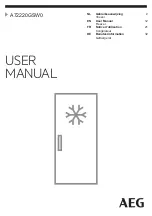
After Sales Support
(AU) 1300 886 649 (NZ) 0800 836 761 | [email protected]
16
WARNING!
• Never use sharp or metallic tools to scrape off frost from the evaporator as you
could damage it. To scrape ice off surfaces, use a plastic scraper.
• Never use boiling water to accelerate defrosting as it may damage the plastic parts.
Other Useful Information (Cont.)
Cleaning the freezer
For hygienic reasons clean the appliance interior and accessories regularly. We
recommend cleaning the freezer after defrosting it, while all frozen food packages and
the storage baskets are already removed from the compartment.
• Make sure the freezer is unplugged from the power supply and all food and the
storage basket are removed.
• Wipe the inside surfaces and the interior accessories with a damp, warm cloth
moistened in a water and baking soda solution. The solution should be about 2
tablespoons of baking soda dissolved in 1 litre of water. Rinse and wipe dry with a
soft cloth.
• Clean the outside of the unit with a damp, well wrung out cloth, keeping the area
of the controls dry. Keep the lid gasket (seal) clean. Do not wash the outside of the
freezer with water.
• Regularly examine the drain in the freezer for defrost water. If necessary, clean the
drain. If the drain is blocked, water will collect in the base of the appliance.
• After cleaning/defrosting, push the drain plug in and also re-plug the drain plug
inside the freezer cabinet.
• Clean any dust and dirt from the area underneath and behind the appliance before
reconnecting the freezer to the power supply.
• After everything is dry, place appliance back into service and return any frozen food
to the freezer. Set the freezer to Fast Freeze mode for 2 hours to cool down the
cabinet fast. Then set it to your normal temperature.
WARNING!
• Never clean the unit with an abrasive, acid, oil or solvent based cleaning agent, or
with abrasive pads or scourers. Never use flammable fluids or sprays for cleaning
as the fumes from these substances can create a fire hazard or explosion.
• Never clean the appliance with a steam cleaner. Moisture could accumulate in
the electrical components, danger of electric shock! Hot vapours can lead to the
damage of plastic parts.
• The appliance must be completely dry before it is placed back into service.
IMPORTANT!
• Ethereal oils and organic solvents can attack plastic parts, e.g. lemon juice or the
juice form orange peel, butyric acid, or cleansers that contain acetic acid. Do not
allow such substances to come into contact with the appliance parts.





































